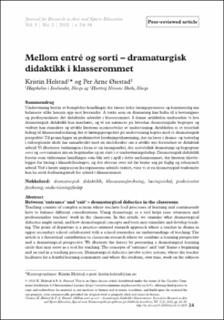| dc.contributor.author | Helstad, Kristin | |
| dc.contributor.author | Øiestad, Per Arne | |
| dc.date.accessioned | 2021-12-02T12:27:46Z | |
| dc.date.available | 2021-12-02T12:27:46Z | |
| dc.date.created | 2021-09-21T09:30:50Z | |
| dc.date.issued | 2021 | |
| dc.identifier.citation | Journal for Research in Arts and Sports Education. 2021, 5 (2), 24-38. | en_US |
| dc.identifier.issn | 2535-2857 | |
| dc.identifier.uri | https://hdl.handle.net/11250/2832572 | |
| dc.description | Copyright © 2021 Kristin Helstad, Per Arne Øiestad.This work is licensed under a Creative Commons Attribution 4.0 International License. | en_US |
| dc.description.abstract | Undervisning består av komplekse handlinger der lærere leder læringsprosesser og kontinuerlig må balansere ulike hensyn opp mot hverandre. Å tenke som en dramaturg kan bidra til å bevisstgjøre og profesjonalisere det didaktiske arbeidet i klasserommet. I denne artikkelen undersøker vi hva dramaturgisk didaktikk kan innebære, og vi ser nærmere på hvordan dramaturgiske begreper og verktøy kan stimulere og utvikle lærerens iscenesettelse av undervisning. Artikkelen er et teoretisk bidrag til klasseromforskning der et læringsperspektiv på undervisning koples med et dramaturgisk perspektiv. Til grunn ligger en praksisrettet forskningstilnærming, der en lærer i drama- og teaterfag i videregående skole har samarbeidet med en skoleforsker om å utvikle nye forståelser av didaktisk arbeid. Vi illustrerer tenkningen i form av en læringssirkel, der aristotelisk dramaturgi og begrepene entré og sorti rammer inn en begynnelse og en slutt i et undervisningsforløp. Dramaturgisk didaktikk forstås som virksomme handlinger som blir satt i spill i dette mellomrommet, der læreren tilrettelegger for læring i klassefellesskapet, og der elevene over tid får bryne seg på faglig og relasjonelt arbeid. Ved å hente inspirasjon fra regissørens arbeid i teatret, viser vi at en dramaturgisk tenkemåte kan ha sterk forklaringskraft for arbeid i klasserommet. | en_US |
| dc.description.abstract | Abstract:
Teaching consists of complex actions where teachers lead processes of learning and continuously have to balance different considerations. Using dramaturgy as a tool helps raise awareness and professionalize teachers’ work in the classroom. In this article, we examine what dramaturgical didactics might entail, and how dramaturgical concepts and tools may stimulate and develop teaching. The point of departure is a practice-oriented research approach where a teacher in drama in upper secondary school collaborated with a school researcher on understandings of teaching. The article is a theoretical contribution to classroom research where we combine a learning perspective and a dramaturgical perspective. We illustrate the theory by presenting a dramaturgical learning circle that may serve as a tool for teaching. The concepts of ‘entrance’ and ‘exit’ frame a beginning and an end in a teaching process. Dramaturgical didactics involve active actions, where the teacher facilitates for a fruitful learning community and where the students, over time, work on the subjects and the resources at play with learning as the ultimate goal. Although the dramaturgical learning circle is developed in a specific context, the underlying thinking might be used in similar contexts. By drawing inspiration from the director’s work in the theater, the article illuminates that a dramaturgical way of thinking may have a strong explanatory power for teachers’ work on all educational levels. | en_US |
| dc.language.iso | nob | en_US |
| dc.rights | Navngivelse 4.0 Internasjonal | * |
| dc.rights.uri | http://creativecommons.org/licenses/by/4.0/deed.no | * |
| dc.subject | dramaturgisk didaktikk | en_US |
| dc.subject | klasseromsforskning | en_US |
| dc.subject | læringssirkel | en_US |
| dc.subject | praksisrettet forskning | en_US |
| dc.subject | undervisningsforløp | en_US |
| dc.subject | dramaturgical didactics | en_US |
| dc.subject | learning circle | en_US |
| dc.subject | classroom research | en_US |
| dc.subject | practice-oriented research | en_US |
| dc.subject | teaching process | en_US |
| dc.title | Mellom entré og sorti – dramaturgisk didaktikk i klasserommet | en_US |
| dc.title.alternative | Between ‘entrance’ and ‘exit’ – dramaturgical didactics in the classroom | en_US |
| dc.type | Peer reviewed | en_US |
| dc.type | Journal article | en_US |
| dc.description.version | publishedVersion | en_US |
| dc.subject.nsi | VDP::Samfunnsvitenskap: 200::Pedagogiske fag: 280 | en_US |
| dc.source.pagenumber | 24-38 | en_US |
| dc.source.volume | 5 | en_US |
| dc.source.journal | Journal for Research in Arts and Sports Education | en_US |
| dc.source.issue | 2 | en_US |
| dc.identifier.doi | 10.23865/jased.v5.2659 | |
| dc.identifier.cristin | 1936397 | |
| cristin.ispublished | true | |
| cristin.fulltext | original | |
| cristin.qualitycode | 1 | |

